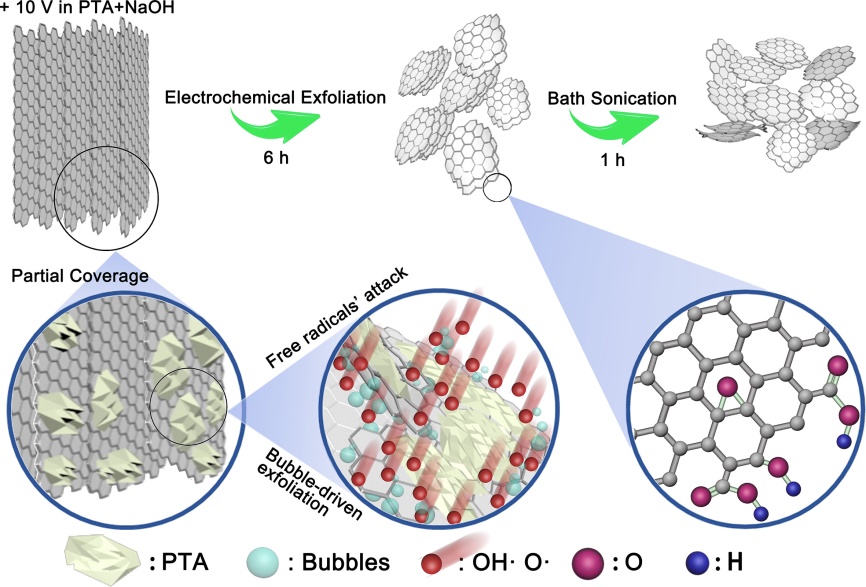Positive Progress in Water-Dispersible Graphene Made by SIMIT
Date:07-03-2018 | 【Print】 【close】
Due to the excellent physical and chemical properties (high electron mobility at room temperature of 15000 cm2/V·s, high thermal conductivity of 5000 W/m·K, high Young's modulus of 350 N/m etc.), graphene has been widely used in many fields such as lithium-ion battery, sensing, energy storage and biomedicine. Thus, the scalable preparation with low cost and effective dispersing of graphene is not only the precondition to realize these applications, but also becomes the key technical problem in scientific research. At present, with cheap graphite as raw materials, intercalation-exfoliation route is one of the most important techniques to produce water-dispersible graphene. Nevertheless, it still faces the challenge of low yield, non-environmental and poor safety. At the same time, the graphene layers are prone to stack back and precipitate due to the van der Waals force and unmatchable surface energy in aqueous solution or other low-boiling organic solvents. These shortcomings greatly limit the extensive use of graphene materials. Therefore, it is essential to develop a green, efficient and low-cost graphene innovative preparation method to disperse in aqueous solution or other low boiling point organic solutions by functionalized modification.
Recently, Guqiao Ding, Peng He and other researchers from graphene material research group of SIMIT (Shanghai Institute of Microsystem and Information Technology, Chinese Academy of Sciences) published an important progress in Green Chemistry. Based on the innovation of electrochemical method and ultrasound-assisted dispersion mechanism, water-dispersible few-layered graphene is obtained in the NaOH-PTA mixed system. In this system, the graphite can be adequately oxidized and initially exfoliated by controlling the PTA coverage on the graphite anode during the electrochemical process. Besides, the subsequent ultrasound treatment can further assist the stable dispersion and achieve the deep exfoliation of graphene. Based on this unique mechanism, few-layered graphene with micron size can be realized with remarkably high yield (87.3%), outstanding dispersibility (8.2 g/L) and good stability in water (at least 8 months), which shows obvious advantages over the previous reports. Meanwhile, due to the anodic protection mechanism in the electrochemical method, the sp2 structure is preserved, leading to the high conductivity (9517 S/m) of the obtained graphene film after mild annealing treatment, which has the great potential in practical applications. Further mechanism investigation identifies the adequate electrochemical oxidation process with anode protection, which is different from the conventional electrochemical mechanism (intercalation, oxidation, expansion and exfoliation). This new strategy overcomes the shortcoming of incomplete intercalation and poor dispersibility of graphene in conventional electrochemical methods. It also identifies the significant role of ultrasound treatment in different conditions. Moreover, electrothermal films based on water-dispersible graphene show advantages of low voltage, high heating rate and uniform temperature distribution, which can be utilized as a new type of electric heating material.
The research team headed by Prof. Guqiao Ding has been focusing on the innovative preparation and novel application of graphene for many years. They have developed many innovative preparing technologies to obtain high-quality graphene, water-dispersible graphene, graphene quantum dots and other high-end graphene materials. This work has been supported by The National Science and Technology Major Project Fund (2011ZX02707), the National Natural Science Foundation of China (11774368, 11227902) and Chinese Academy of Sciences (XDA02040000).
Links: http://pubs.rsc.org/en/content/articlelanding/2018/gc/c7gc03345a/unauth#!divAbstract

The mechanism of anode PTA coverage for enhanced electrochemical oxidation